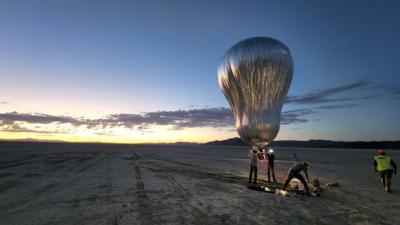Thu, Oct 13, 2022
Atmospheric Assestment System in Development for Venutian Exploration
The Jet Propulsion Laboratory completed the first of a battery of test flights for their prototype aerial robotic balloon.

The system is hoped to help uncover atmospheric conditions on the planet Venus, deploying the balloon into the intense heat, pressure, and corrosive gases found in its environment. The balloon is a part of a concept that pairs it with an orbiting platform outside the atmosphere. The duo would allow the orbiting portion to function as a communications relay while allowing the robotic balloon, or "aerobot" , to descend into the atmosphere proper and act as a submerged analysis platform.
The idea is promising enough for the JPL to begin work on preliminary designs that would see the aerobot make humanity’s best observation of Venus in decades, following up on a balloon-borne survey done underthe Soviet’s Vega mission in 1985. Those balloons lasted only 46 hours before losing power, a record that should be handily outperformed with modern technology - provided, of course, that they’re hardy enough to survive. The ultimate goal for NASA is to create an aerobot that can travel by riding the Venusian winds, circumnavigating the planet for at least 100 days while monitoring the planet with as many sensors as they can pack aboard.
The Jet Propulsion Lab tested the general concept with the assistance of the Near Space Corporation to assess the feasibility of a smaller 1/3 scale demonstrator over Nevada's Black Rock Desert. The test saw the silvery aerobot ascent to 4,000 feet, roughly equivalent to the atmospheric conditions found at 180,000 ft AGL on Venus. The prototype appears to have been a success, ascending and holding altitude before coming back down to earth with the trademark grace of lighter-than-air aircraft.
“We’re extremely happy with the performance of the prototype. It was launched, demonstrated controlled-altitude maneuvers, and was recovered in good condition after both flights,” said robotics technologist Jacob Izraelevitz, who leads the aerobot's development as the JPL principal investigator over flight testing. “We’ve recorded a mountain of data from these flights and are looking forward to using it to improve our simulation models before exploring our sister planet."
More News
Hold Procedure A predetermined maneuver which keeps aircraft within a specified airspace while awaiting further clearance from air traffic control. Also used during ground operatio>[...]
Altitude Readout An aircraft’s altitude, transmitted via the Mode C transponder feature, that is visually displayed in 100-foot increments on a radar scope having readout cap>[...]
Aero Linx: European Hang Gliding and Paragliding Union (EHPU) The general aim of the EHPU is to promote and protect hang gliding and paragliding in Europe. In order to achieve this>[...]
Also: Skydio Chief, Uncle Sam Sues, Dash 7 magniX, OR UAS Accelerator US Secretary of the Air Force Frank Kendall was given a turn around the patch in the 'X-62A Variable In-flight>[...]
"The need for innovation at speed and scale is greater than ever. The X-62A VISTA is a crucial platform in our efforts to develop, test and integrate AI, as well as to establish AI>[...]
 ANN's Daily Aero-Term (05.09.24): Hold Procedure
ANN's Daily Aero-Term (05.09.24): Hold Procedure ANN's Daily Aero-Term (05.06.24): Altitude Readout
ANN's Daily Aero-Term (05.06.24): Altitude Readout ANN's Daily Aero-Linx (05.06.24)
ANN's Daily Aero-Linx (05.06.24) Airborne-NextGen 05.07.24: AI-Piloted F-16, AgEagle, 1st 2 WorldView Sats
Airborne-NextGen 05.07.24: AI-Piloted F-16, AgEagle, 1st 2 WorldView Sats Aero-News: Quote of the Day (05.07.24)
Aero-News: Quote of the Day (05.07.24)



